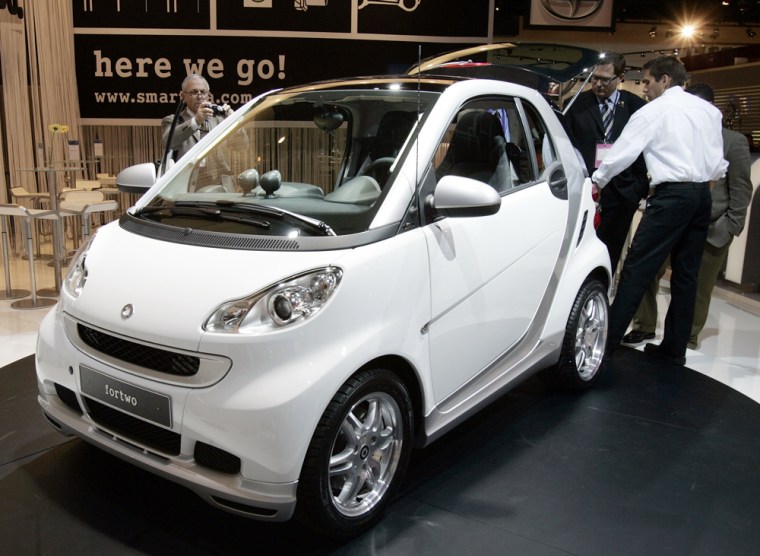Despite a rush to offer them the smallest fuel-sipping cars, it seems one aphorism is likely to ring true for some time when it comes to Americans and their cars — size matters.
Persistently high gasoline prices have spurred automakers to make plans to introduce tiny cars into the U.S. market, beginning early next year, when Mercedes Car Group plans to begin selling tiny, two-seater Smart models. At the New York auto show in April, General Motors unveiled three small Chevrolet concept cars aimed at young car buyers in urban markets.
But research from consulting firm CSM Worldwide shows that American consumers are not very big on very small cars, which are popular in many markets around the world because they are so fuel efficient and easy to park.
Dave Terebessy, an automotive analyst at CSM, said American buyers are likely to avoid cars that are smaller than the subcompact vehicles already on the U.S. market such as the Honda Fit, Chevy Aveo and Toyota Yaris.
American consumers, he said, are likely to forfeit a few miles per gallon rather than buy a car less than 150 inches in length, about the size of the Mini Cooper, which is the shortest car currently sold in the United States. All three of the Chevrolet concepts shown at the New York auto show were under 150 inches, while the new Smart Car will come in at just 106 inches.
Fewer than 100,000 minicars will be sold annually through 2013, according to CSM, while annual sales of subcompacts like the Fit and Yaris are expected to rise from an estimated 300,000 in 2007 to over 550,000 by 2013.
“This is an important vehicle segment and we expect it to grow quite a bit,” Terebessy said, referring to subcompacts. “It’s affordable for first-time buyers and will meet consumer demand for fuel efficiency — those are the two main propositions driving the growth in [subcompact] cars. And over the next decade and in the future we expect to see the population growing and a greater emphasis on environmental products — these factors are also playing into the expected increase in sales.”
Smart USA, a division of the Mercedes Car Group, is revving up a cross-country road show to introduce the tiny, two-seater Smart “fortwo” car, which is due to go on sale in the United States in early 2008 through a network of up to 70 dealerships.
Smart cars are already sold in 36 countries, and over 750,000 fortwo vehicles have been sold since their introduction, according to Smart USA. The entry-level Smart fortwo, which measures almost 106 inches in length, will carry a sticker price under $12,000. The vehicle is designed to achieve some 40 MPG under normal driving conditions and current standards, according to Smart USA.
GM also is looking at bringing low-cost minicars to the United States, opening up a new segment in the world’s biggest automobile market, but GM executives have shown some hesitancy about the segment.
GM customer studies have shown that Americans, who pay relatively little for gas compared with drivers in other countries, generally prefer bigger vehicles, Group Vice President John Smith said in March. Rising gas prices are boosting demand for small cars, but truly tiny cars like the Smart are unlikely to make gains unless gas prices go significantly higher, he said.
Smith said that the company's long-term internal forecast shows gas at about $2.50 a gallon, a range that he said would not inspire “a seismic shift in consumption habits.”
All the subcompact vehicles on the U.S. market already offer decent fuel economy, notes Terebessy, and at $12,000 for the basic model, the Smart fortwo comes in at around the same price as a Toyota Yaris or Honda Fit.
“So there is just not a whole lot to swing consumers to a Smart,” Terebessy said. “And when people think about accidents, they’d rather be in a larger vehicle."
He said customers will conclude they get more for their money in a subcompact, rather than a minicar.
"The consumers who would still go for these (tiny) cars are those who have a strong attraction to their look, or really want a car because they are easier to park in a big city," he said.
